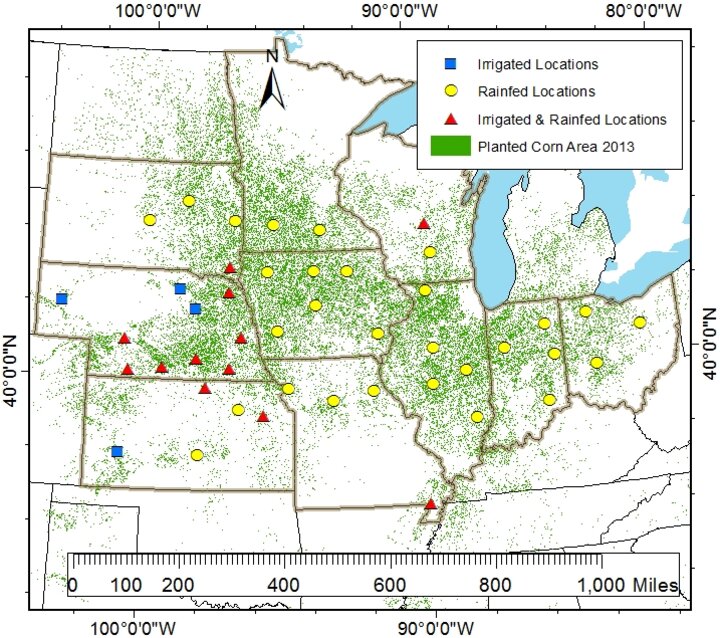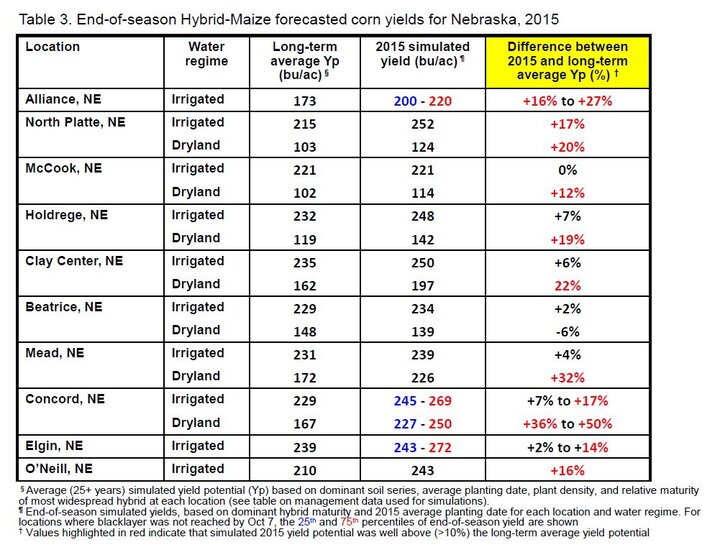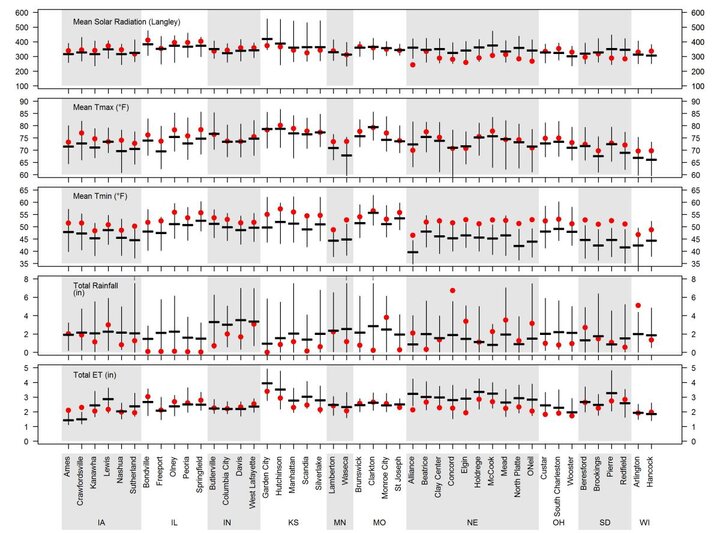Oct. 9, 2015

Figure 1. Locations used to simulate 2015 forecasted corn yields using Hybrid Maize.
See corn yield projections, as of Oct. 7, for these sites in Tables 3-5.
Corn grain filling is complete in approximately 80% of the acreage across the Corn Belt based on simulations performed Oct 7. Corn has not reached blacklayer yet in a few locations in the northern fringe of the Corn Belt (northern Nebraska, Iowa, South Dakota, Minnesota, and Wisconsin), but soon will.
Starting on July 15 in collaboration with faculty and extension educators from 10 universities we performed bi-weekly simulations of corn growth and development to assess the impact of current season weather on yields and to determine the uncertainty on final yields related to weather conditions for the rest of the season, providing a range of possible yields and their probabilities in comparison to the long-term means. Details about Hybrid-Maize and the underpinning methodology to forecast end-of-season yields, as well as information on interpretation and uses of yield forecasts, can be found in a previous CropWatch article.
Briefly, the Hybrid-Maize model simulates daily corn growth and development and final grain yield under irrigated and dryland conditions. The model estimates “yield potential,” which is the yield obtained when the crop is not limited by nutrient deficiencies, diseases, insect pressure, or weed competition, conditions that represent an “optimal management” scenario. It also assumes a uniform plant stand at the specified plant population and no problems from flooding or hail. Because weather, soil, and management factors are “location-specific,” Hybrid-Maize simulations are based on actual weather data, soil, and typical management practices at the location being simulated as provided by university agronomists, extension educators, and DuPont Pioneer agronomists in each state (see Tables 1-2).
The results of simulating end-of-season yield as of Oct. 7 are shown for 45 locations in Tables 3-5. Blacklayer had been reached at 80% of the locations. For these locations, final simulated yield is reported and compared relative to the long-term simulated yield. For locations in the northern Corn Belt where maturity was not reached yet, we provide the likely range on end-of-season yield.

Irrigated Yields Near- or Above-Average
The crop has reached black layer at 12 of the 16 irrigated sites; sites not yet reaching blacklayer were in northeast and western Nebraska and Wisconsin. Among those where blacklayer was reached, final simulated yields are near average (±10%) relative to the long-term yield in 75% of the sites. In the other sites, simulated yields are above the long-term mean, with, on average, yield being 15% above the long-term mean. Yield prospects are also good for the other locations where corn has not reached blacklayer.
Favorable Dryland Yields Across the Entire Corn Belt
In general, the dryland yield scenario looks very favorable. Black layer was reached at 35 of the 41 locations, with an average yield 20% above the long-term mean. Among those locations, final simulated yields are near average (±10%) relative to the long-term yield in 30% of the dryland sites. In 70% of the dryland sites, simulated yields are above the long-term mean (on average, 20% above average). Yield scenarios for those locations where blacklayer has not been reached are favorable and above the long-term mean in most cases.
Faster Corn Development Due to Warmer Temperatures in September
A summary of recent weather conditions [daily solar radiation, maximum and minimum temperature, total rainfall, and total reference evapotranspiration (ET)] for Sept. 16 to Oct. 6 is presented in Figure 2 to help with the interpretation of the forecasted corn yields. Vertical bars indicate the range for these variables based on 20+ years of weather records. The horizontal thick line indicates the long-term average while the red dots indicate the 2015 averages.

Daytime temperatures during this period was near normal across the entire Corn Belt, but nighttime temperatures were consistently 5°F above their historical averages for this period. This hastened crop maturity and reduced the risk of early killing frost. On the other hand, none of the places under evaluation has received frost; in fact, there was only one location where the minimum temperature dropped below 33°F before Oct. 6 (North Platte on Sept. 19). This has provided a much longer growing season than usual. Rainfall was consistently below normal in the central and eastern Corn Belt, but this has had little impact on yield likely because the dry period occurred by the time grain filling was ending.
Conclusions
At all 45 Corn Belt locations evaluated, end-of-season yields for 2015 are highly favorable for irrigated and dryland corn, with yields above the long-term average in 25% of the irrigated and 73% of the rainfed fields. Even at locations where corn has not matured, yield prospects are above the long-term average.
These forecasts do not take into consideration problems with stand emergence due to crop residues, hail/flooding damage, replanting situations, disease/insect issues, or nutrient deficiencies. Likewise, there can be late-season diseases and high winds or hail events that can cause yield loss as the crop matures or awaits harvest. Indeed, early in the season, waterlogging was important in the eastern Corn Belt, and in many cases it led to a lack of stand uniformity and N leaching. Therefore, in fields negatively affected by these constraints, actual yields will be lower than these estimates.
Francisco Morell, UNL Post-doctoral Research Associate
Patricio Grassini, UNL Assistant Professor of Agronomy and Horticulture, Extension Cropping System Specialist and Water for Food Institute Fellow
Haishun Yang, UNL Associate Professor of Agronomy and Horticulture and Water for Food Institute Fellow
Kenneth Cassman, UNL Professor of Agronomy and Horticulture and Robert B. Daugherty Water for Food Institute Fellow
Roger Elmore, UNL Professor of Agronomy and Horticulture, Extension Cropping System Specialist and Water for Food Institute Fellow
Justin Van Wart, UNL Post-doctoral Research Associate
Keith Glewen, Nebraska Extension Educator
Jennifer Rees, Nebraska Extension Educator
Greg Kruger, UNL Assistant Professor of Agronomy and Horticulture and UNL Extension Cropping System Specialist
Charles Shapiro, UNL Extension Soils Scientist – Crop Nutrition and Professor of Agronomy and Horticulture
Ignacio Ciampitti, Crop Production and Cropping System Specialist and Assistant Professor of Agronomy, Kansas State University
Mark Licht, Extension Cropping System Agronomist, Iowa State University
Peter Thomison, Extension Specialist and Professor, Ohio State University
Joe Lauer, Professor, University of Wisconsin-Madison
Sylvie Brouder & Tony Vyn, Professors of Agronomy, Purdue University
